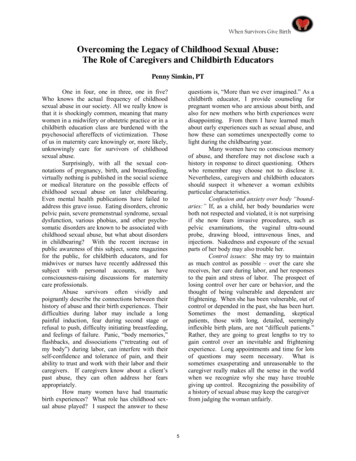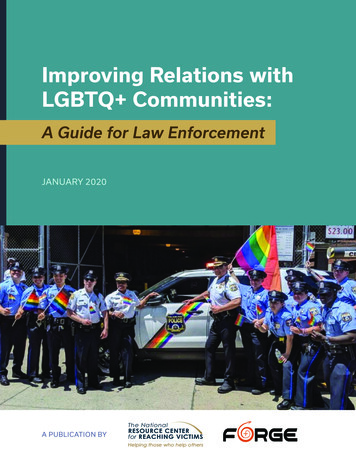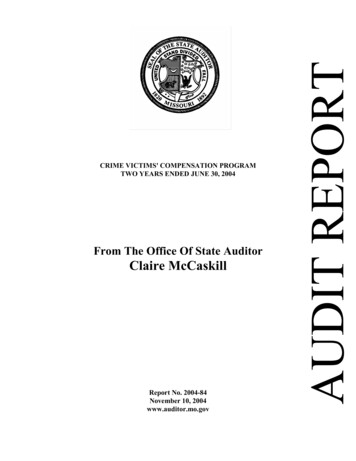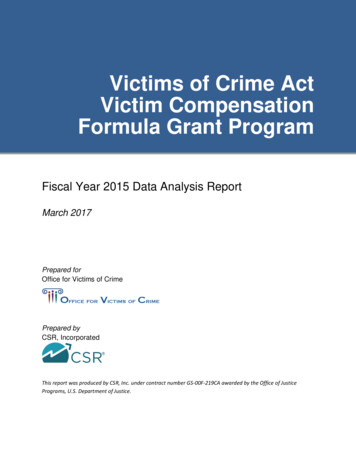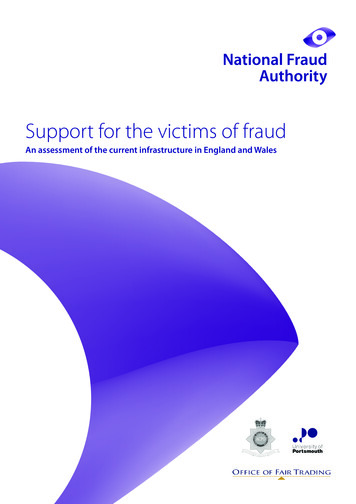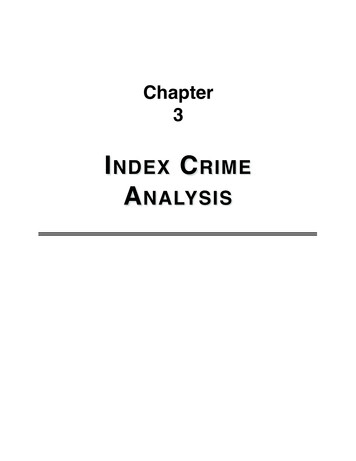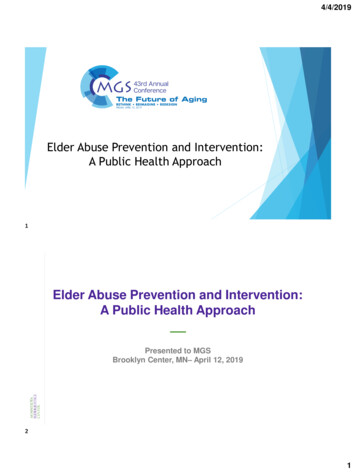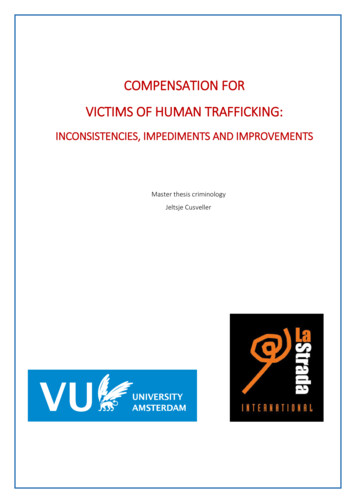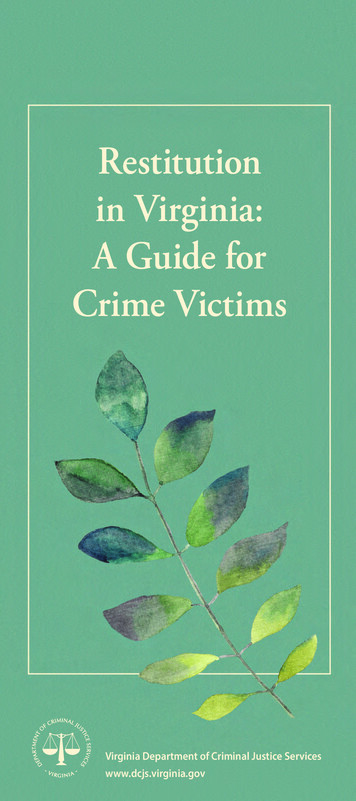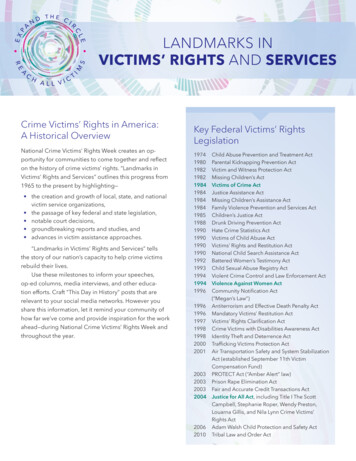
Transcription
ACIMRESLEEXPHD T E CIRCANHALL VICLANDMARKS INVICTIMS’ RIGHTS AND SERVICESTCrime Victims’ Rights in America:A Historical OverviewNational Crime Victims’ Rights Week creates an opportunity for communities to come together and reflecton the history of crime victims’ rights. “Landmarks inVictims’ Rights and Services” outlines this progress from1965 to the present by highlighting— the creation and growth of local, state, and nationalvictim service organizations, the passage of key federal and state legislation, notable court decisions, groundbreaking reports and studies, and advances in victim assistance approaches.“Landmarks in Victims’ Rights and Services” tellsthe story of our nation’s capacity to help crime victimsrebuild their lives.Use these milestones to inform your speeches,op-ed columns, media interviews, and other education efforts. Craft “This Day in History” posts that arerelevant to your social media networks. However youshare this information, let it remind your community ofhow far we’ve come and provide inspiration for the workahead—during National Crime Victims’ Rights Week andthroughout the year.Key Federal Victims’ 619971998199820002001200320032003200420062010Child Abuse Prevention and Treatment ActParental Kidnapping Prevention ActVictim and Witness Protection ActMissing Children’s ActVictims of Crime ActJustice Assistance ActMissing Children’s Assistance ActFamily Violence Prevention and Services ActChildren’s Justice ActDrunk Driving Prevention ActHate Crime Statistics ActVictims of Child Abuse ActVictims’ Rights and Restitution ActNational Child Search Assistance ActBattered Women’s Testimony ActChild Sexual Abuse Registry ActViolent Crime Control and Law Enforcement ActViolence Against Women ActCommunity Notification Act(“Megan’s Law”)Antiterrorism and Effective Death Penalty ActMandatory Victims’ Restitution ActVictims’ Rights Clarification ActCrime Victims with Disabilities Awareness ActIdentity Theft and Deterrence ActTrafficking Victims Protection ActAir Transportation Safety and System StabilizationAct (established September 11th VictimCompensation Fund)PROTECT Act (“Amber Alert” law)Prison Rape Elimination ActFair and Accurate Credit Transactions ActJustice for All Act, including Title I The ScottCampbell, Stephanie Roper, Wendy Preston,Louarna Gillis, and Nila Lynn Crime Victims’Rights ActAdam Walsh Child Protection and Safety ActTribal Law and Order Act
Great thoughts speak only to the thoughtful mind, butgreat actions speak to all mankind.— T H E O D O R E R O O S E V E LT ( 1 8 5 8 - 1 9 1 9 )19651974 The first crime victim compensation program isestablished in California. By 1970, five additional compensation programs arecreated in New York, Hawaii, Massachusetts, Maryland, and the U.S. Virgin Islands.1972 The first three victim assistance programs are established: Aid for Victims of Crime in St. Louis, Missouri,(now the Crime Victim Advocacy Center). Bay Area Women Against Rape in SanFrancisco, California. D.C. Rape Crisis Center in Washington, DC. The first “Victims’ Rights Week” is organized by thePhiladelphia District Attorney. Citizen activists from across the country unite toexpand victim services and increase recognition ofvictims’ rights through the formation of the NationalOrganization for Victim Assistance (NOVA).HD T E CIREXLEAIMRES2C Congress passes the Child Abuse Prevention andTreatment Act, which establishes the National Centeron Child Abuse and Neglect. The new Center establishes an information clearinghouse and providestechnical assistance and model programs.CP The results of the first annual National CrimeVictimization Survey are released. The survey, commissioned by the President’s Commission on LawEnforcement and the Administration of Justice, asksU.S. household members about their exposure tocrime. It is intended to complement the FederalBureau of Investigation’s (FBI) annual compilation ofcrimes reported to law enforcement agencies.N The first law enforcement-based victim assistanceprograms are established in Fort Lauderdale, Florida,and Indianapolis, Indiana.19751973A The Law Enforcement Assistance Administration(LEAA) funds the first victim/witness programs in theBrooklyn and Milwaukee District Attorneys’ Officesand seven other offices through a grant given to theNational District Attorneys Association to establishmodel assistance programs for victims, encouragevictim cooperation, and improve prosecution.HALL VICT 2 0 1 8 N C V R W R E S O U R C E G U I D E L A N D M A R K S I N V I C T I M S ’ R I G H T S A N D S E RV I C E S
1976 Parents Of Murdered Children, Inc. (POMC), a selfhelp support group, is founded in Cincinnati, Ohio. The National Organization for Women forms a taskforce to examine the problem of battering. It callsfor research into the problem, along with money forbattered women’s shelters. The first national conference on battered women issponsored by the Milwaukee Task Force on Womenin Milwaukee, Wisconsin. In Fresno County, California, Chief Probation Officer James Rowland creates the first victim impactstatement to provide the sentencing court with anobjective inventory of victim injuries and losses. The first hotline for battered women is started byWomen’s Advocates in St. Paul, Minnesota. Women’s Advocates and Haven House in Pasadena,California, establish the first shelters for batteredwomen. Nebraska and Wisconsin become the first states toabolish the marital rape exemption. Minnesota becomes the first state to allow probablecause (warrantless) arrests in cases of domesticassault, whether or not a protection order has beenissued.1979 Frank G. Carrington founds the Crime Victims’ LegalAdvocacy Institute, Inc., to promote the rights ofcrime victims in the civil and criminal justice systems.The nonprofit organization is renamed VALOR, theVictims’ Assistance Legal Organization, in 1981. The Office on Domestic Violence is established inthe U.S. Department of Health and Human Services(later closed in 1981). The World Society of Victimology is formed topromote research relating to crime victims andvictim assistance, advocate for victims’ interests, andadvance cooperation of international, regional, andlocal agencies concerned with crime victims’ issues.1977 The National Association of Crime Victim Compensation Boards is established by the existing 22 statevictim compensation programs to foster a nationwide network of compensation programs. Oregon becomes the first state to enact a mandatory arrest law in domestic violence cases.1980 Mothers Against Drunk Driving (MADD) is foundedafter the death of 13-year-old Cari Lightner, who waskilled by a repeat drunk-driving offender. The firsttwo MADD chapters are established in Sacramento,California, and Annapolis, Maryland. Congress passes the Parental Kidnapping Prevention Act of 1980.1978 The National Coalition Against Sexual Assault isformed to combat sexual violence and promoteservices for rape victims. The first National Day of Unity is established inOctober by NCADV to mourn battered women whohave died, celebrate women who have survived theviolence, and honor all who have worked to enddomestic violence.NHD T E CIRSRE 3ACIM2 0 1 8 N C V R W R E S O U R C E G U I D E L A N D M A R K S I N V I C T I M S ’ R I G H T S A N D S E RV I C E SLEEXACP The National Coalition Against Domestic Violence(NCADV) is organized as a voice for the batteredwomen’s movement on a national level. Wisconsin passes the first “Crime Victims’ Bill ofRights.”HALL VICT
The first Victim Impact Panel is sponsored by Remove Intoxicated Drivers (RID) in Oswego County,New York.1981 President Ronald Reagan proclaims the first national“Crime Victims Week” in April. The abduction and murder of six-year-old AdamWalsh prompts a national campaign to raise publicawareness about missing children and enact laws tobetter protect children. The Attorney General’s Task Force on Violent Crimerecommends that a separate national task force becreated to examine victims’ issues.1982 In a Rose Garden ceremony, President Reaganappoints members to the Task Force on Victimsof Crime, which holds public hearings in six citiesacross the nation to focus attention on the needs ofcrime victims. The Task Force’s Final Report offers68 recommendations that become the frameworkfor the advancement of new programs and policies. Its final recommendation, to amend the SixthAmendment of the U.S. Constitution to guaranteethat “the victim, in every criminal prosecution, shallhave the right to be present and to be heard at allcritical stages of judicial proceeding,” becomes avital source of new energy to secure constitutionalamendments for victims’ rights in each state. The Victim and Witness Protection Act of 1982brings “fair treatment standards” to victims and witnesses in the federal criminal justice system.NLEAIMRES4C1983 The Office for Victims of Crime (OVC) is establishedby the U.S. Department of Justice within the Officeof Justice Programs to implement recommendationsfrom the President’s Task Force on Victims of Crime.OVC establishes a national resource center, trainsprofessionals, and develops model legislation toprotect victims’ rights. U.S. Attorney General William French Smith establishes a Task Force on Family Violence, which holdssix public hearings across the United States. U.S. Attorney General Smith issues the first AttorneyGeneral Guidelines for Victim and Witness Assistance, which outlines standards for federal victimand witness assistance and the implementation ofvictims’ rights contained in the federal Victim andWitness Protection Act of 1982. In April, President Reagan honors crime victims in aWhite House Rose Garden ceremony. The First National Conference of the Judiciary onVictims of Crime is held at the National JudicialCollege in Reno, Nevada, with support from theNational Institute of Justice. Conferees developrecommendations for the judiciary on victims’ rightsand services. President Reagan proclaims the first NationalMissing Children’s Day in observance of the fourthanniversary of the disappearance of six-year-oldEtan Patz.HD T E CIREXA Congress abolishes, through failure of appropriations, the Law Enforcement Assistance Administration; many grassroots and system-based victimassistance programs close.CP California becomes the first state to amend itsconstitution to address the interests of crime victims by establishing a constitutional right to victimrestitution. The passage of the Missing Children’s Act of 1982helps guarantee that identifying information aboutmissing children is promptly entered into the FBINational Crime Information Center (NCIC) computer system.HALL VICT 2 0 1 8 N C V R W R E S O U R C E G U I D E L A N D M A R K S I N V I C T I M S ’ R I G H T S A N D S E RV I C E S
Wisconsin passes the first Child Victim and WitnessBill of Rights. The International Association of Chiefs of PoliceBoard of Governors adopts a Crime Victims’ Bill ofRights and establishes a Victims’ Rights Committeeto focus attention on the needs of crime victims bylaw enforcement officials nationwide. Congress passes the Family Violence Prevention andServices Act, which earmarks federal funding forprograms serving victims of domestic violence. Concerns of Police Survivors (COPS) is organized atthe first police survivors’ seminar held in Washington, DC, by 110 relatives of officers killed in the lineof duty. A victim/witness notification system is establishedwithin the Federal Bureau of Prisons.1984 The passage of the Victims of Crime Act (VOCA)establishes the Crime Victims Fund, made up of federal criminal fines, penalties, and bond forfeitures, tosupport state victim compensation and local victimassistance programs. President Reagan signs the Justice Assistance Act,which establishes a financial assistance programfor state and local government and funds 200 newvictim service programs. The National Center for Missing and ExploitedChildren is established as the national resourceagency for missing children. The Center was mandated as part of the Missing Children’s AssistanceAct of 1984. Victim/witness coordinator positions are establishedin the U.S. Attorneys’ Offices within the U.S. Department of Justice. California State University, Fresno, initiates thefirst Victim Services Certificate Program offered foracademic credit by a university. OVC establishes the National Victims ResourceCenter, now named the Office for Victims of CrimeResource Center (OVCRC), to serve as a clearinghouse for OVC publications and other resources.1985 The Crime Victims Fund deposits total 68 million. The National Victim Center (renamed the NationalCenter for Victims of Crime in 1998) is foundedin honor of Sunny von Bülow to provide a strongnational voice on behalf of crime victims and toeducate Americans about the devastating effect ofcrime on our society. The National Minimum Drinking Age Act of 1984is enacted, providing strong incentives to states toraise the minimum age for drinking to 21, savingthousands of young lives in years to come. The United Nations General Assembly adopts theDeclaration of Basic Principles of Justice for Victimsof Crime and Abuse of Power that serves as thebasis for victim service reform at national and locallevels throughout the world. The Spiritual Dimension in Victim Services inCharleston, South Carolina, is founded to involvethe faith community in violence prevention andvictim assistance. President Reagan announces the Child Safety Partnership to enhance private sector efforts to promotechild safety, clarify information about child victimization, and increase public awareness of child abuse.NHD T E CIRSRE 5ACIM2 0 1 8 N C V R W R E S O U R C E G U I D E L A N D M A R K S I N V I C T I M S ’ R I G H T S A N D S E RV I C E SLEEXACP The Task Force on Family Violence presents itsreport to the U.S. Attorney General with recommendations for action, including improving the criminaljustice system’s response to battered women andestablishing prevention and awareness activities,education and training, and data collection andreporting.HALL VICT
The U.S. Surgeon General issues a report identifyingdomestic violence as a major public health problem.1986 The Crime Victims Fund deposits total 62 million. OVC awards the first grants to support state victimassistance and compensation programs. Two years after its passage, the Victims of Crime Actis amended by the Children’s Justice Act to providefunds specifically for the investigation and prosecution of child abuse. More than 100 victim advocates meet in Washington, DC, at a forum sponsored by NOVA, andformally agree to seek a federal constitutionalamendment on victims’ rights. Rhode Island passes a victims’ rights constitutionalamendment granting victims the rights to restitution, to submit victim impact statements, and to betreated with dignity and respect. MADD’s “Red Ribbon Campaign” enlists motoriststo display a red ribbon on their automobiles, signaling a pledge to drive safely and soberly during theholidays. (This national public awareness effort hassince become an annual campaign.) By year’s end, 35 states have established victimcompensation programs.1987 October is officially designated as National Domestic Violence Awareness Month to honor batteredwomen and those who serve them. In a 5-4 decision, the U.S. Supreme Court rules inBooth v. Maryland (482 U.S. 496) that victim impactstatements are unconstitutional (in violation of theEighth Amendment) when applied to the penaltyphase of a capital trial because “only the defendant’s personal responsibility and moral guilt” maybe considered in capital sentencing. Significantdissenting opinions are offered. Victims and advocates in Florida, frustrated by fiveyears of inaction by their legislature on a proposedvictims’ rights constitutional amendment, begin apetition drive. Thousands of citizens sign petitionssupporting constitutional protection for victims’rights. The Florida legislature reconsiders, and theconstitutional amendment appears on the 1988ballot. The Crime Victims Fund deposits total 93 million. OVC sets aside funds for the Victim Assistance inIndian Country grant program to provide directservices to Native Americans by establishing “onreservation” victim assistance programs in IndianCountry.HD T E CIREXLEAIMRES6C NCADV establishes the first national toll-free domestic violence hotline.CP The National Victims’ Constitutional AmendmentNetwork and Steering Committee are formed at ameeting hosted by the National Center for Victimsof Crime. This initiative becomes instrumental in thepassage of victims’ rights amendments throughoutthe United States.N The American Correctional Association establishesa Task Force on Victims of Crime.1988 The Crime Victims Fund deposits total 77 million.A Security on Campus, Inc., (now the Clery Center) isestablished by Howard and Connie Clery, followingthe tragic robbery, rape, and murder of their daughter, Jeanne, at Lehigh University in Pennsylvania.SOC raises national awareness about crime andvictimization on our nation’s campuses.HALL VICT 2 0 1 8 N C V R W R E S O U R C E G U I D E L A N D M A R K S I N V I C T I M S ’ R I G H T S A N D S E RV I C E S
The National Aging Resource Center on ElderAbuse is established by a cooperative agreementamong the American Public Welfare Association, theNational Association of State Units on Aging, andthe University of Delaware. Renamed the NationalCenter on Elder Abuse, it provides information andstatistics on this issue of growing concern. State v. Ciskie is the first case to allow the use ofexpert testimony to explain the behavior and mentalstate of an adult rape victim. The testimony is usedto show why a victim of repeated physical andsexual assaults by her intimate partner would notimmediately call the police or take action. The juryconvicts the defendant on four counts of rape. The Drunk Driving Prevention Act is passed, and allstates raise the minimum drinking age to 21. Victims’ rights constitutional amendments are introduced in Arizona, California, Connecticut, Delaware,Michigan, South Carolina, and Washington. Florida’samendment is placed on the November ballot,where it passes with 90 percent of the vote. Michigan’s amendment passes with more than 80 percentof the vote. OVC sponsors the first “Indian Nations: Justice forVictims of Crime” conference in Rapid City, SouthDakota. Amendments to the Victims of Crime Act legislatively establish the Office for Victims of Crime, elevatethe position of Director by making Senate confirmation necessary for appointment, and encouragestate compensation programs to cover victims ofdomestic violence, homicide, and drunk driving.In addition, VOCA amendments, at the behest ofMADD and POMC, add a new “priority” category forfunding victim assistance programs for “previouslyunderserved victims of violent crime.” The Crime Victims Fund deposits total 133 million. In a 5-4 decision, the U.S. Supreme Court reaffirmsin South Carolina v. Gathers its 1987 decision inBooth v. Maryland that victim impact evidence andarguments are unconstitutional when applied to thepenalty phase of a capital trial. Again, significantdissenting opinions are offered. The legislatures in Texas and Washington passvictims’ rights constitutional amendments. Both areratified by voters.1990 The Crime Victims Fund deposits total 146 million. Congress passes the Hate Crime Statistics Act,requiring the U.S. Attorney General to collect dataon the incidence of certain crimes motivated byprejudice based on race, religion, sexual orientation,or ethnicity. The Student Right to Know and Campus SecurityAct, requiring institutions of higher education todisclose murder, rape, robbery, and other crimes oncampus, is signed into law by President George H.W.Bush. Congress passes the Victims of Child Abuse Act,which features reforms to make the federal criminaljustice system less traumatic for child victims andwitnesses. The Victims’ Rights and Restitution Act of 1990incorporates a Bill of Rights for federal crime victimsand codifies services that should be available tovictims of crime. Congress passes legislation proposed by MADDto prevent drunk drivers and other offenders fromfiling bankruptcy to avoid paying criminal restitutionor civil fines.NHD T E CIRSRE 7ACIM2 0 1 8 N C V R W R E S O U R C E G U I D E L A N D M A R K S I N V I C T I M S ’ R I G H T S A N D S E RV I C E SLEEXACP OVC establishes a Federal Emergency Fund forvictims in the federal criminal justice system.1989HALL VICT
The Arizona petition drive to place the victims’ rightsconstitutional amendment on the ballot succeeds,and the amendment is ratified by voters. The first National Incidence Study on Missing,Abducted, Runaway, and Thrownaway Children inAmerica finds that in a one-year period there wereas many as 450,000 runaways; 127,000 thrownaways; 438,000 children who were lost, injured,or otherwise missing; 4,600 children abducted bynonfamily members; and 114,600 children whowere targets of attempted abduction by nonfamilymembers. The National Child Search Assistance Act requireslaw enforcement to enter reports of missing childrenand unidentified persons into the FBI’s NCIC computer system. California becomes the first state in the country topass a law against stalking, CA Penal Code Section646.9.1991 The Crime Victims Fund deposits total 128 million. U.S. Representative Ileana Ros-Lehtinen (R-FL)introduces the first Congressional Joint Resolution(H.R.J. Res. 247) to place victims’ rights in the U.S.Constitution. California State University, Fresno, approves the firstbachelor’s degree program in victimology in thenation.NLEAIMRES8C The American Probation and Parole Associationestablishes a Victim Issues Committee to examinevictims’ issues and concerns related to communitycorrections. The New Jersey legislature passes a victims’ rightsconstitutional amendment, which is ratified by voters in November. Colorado legislators introduce a victims’ rights constitutional amendment on the first day of NationalCrime Victims’ Rights Week. The bill is unanimouslypassed by both Houses to be placed on the ballot in1992. In an 8-0 decision, the U.S. Supreme Court rules inSimon & Schuster v. New York Crime Victims Boardthat New York’s notoriety-for-profit statute wasoverly broad and unconstitutional. Notoriety-forprofit statutes had been passed by many states bythis time to prevent convicted criminals from profiting from the proceeds of depictions of their crimesin the media or publications.HD T E CIREXA U.S. Attorney General William P. Barr issues newcomprehensive guidelines that establish proceduresfor the federal criminal justice system to respond tothe needs of crime victims. The 1991 Attorney General Guidelines for Victim and Witness Assistanceimplement new protections of the Crime ControlAct of 1990, integrating requirements of the CrimeVictims’ Bill of Rights, the Victims of Child Abuse Act,and the Victim and Witness Protection Act.CP The National Center for Victims of Crime releasesAmerica Speaks Out, a report on the first nationalpublic opinion poll to examine citizens’ attitudesabout violence and victimization. In a 7-2 decision in Payne v. Tennessee (501 U.S.808), the U.S. Supreme Court reverses its earlierdecisions in Booth v. Maryland (1987) and SouthCarolina v. Gathers (1989) and rules that testimonyand prosecutorial arguments commenting on themurder victim’s good character, as well as how thevictim’s death affected his or her survivors, do notviolate the defendant’s constitutional rights in acapital case.HALL VICT 2 0 1 8 N C V R W R E S O U R C E G U I D E L A N D M A R K S I N V I C T I M S ’ R I G H T S A N D S E RV I C E S
The Washington Secretary of State implements thenation’s first Address Confidentiality Program, whichprovides victims of domestic violence, stalking, andsexual assault an alternative, confidential mailing address and secures the confidentiality of two normallypublic records—voter registration and motor vehiclerecords. By the end of 1991, seven states have incorporatedvictims’ rights into their state constitutions. Five states—Colorado, Kansas, Illinois, Missouri, andNew Mexico—ratify victims’ rights constitutionalamendments. Twenty-eight states pass anti-stalking laws. Massachusetts passes a landmark bill creating astatewide computerized domestic violence registryand requiring judges to check the registry whenhandling such cases.19931992 The Crime Victims Fund deposits total 221 million. The Crime Victims Fund deposits total 144 million. The National Center for Victims of Crime releasesRape in America: A Report to the Nation, a groundbreaking study that includes data on rape frequency,victims’ reporting rate to police, the impact of rapeon victims’ mental health, and the effect of mediadisclosure of victim identities on reporting rape tolaw enforcement. Wisconsin ratifies its victims’ rights constitutionalamendment, bringing the total number of stateswith these amendments to 14. The Association of Paroling Authorities Internationalestablishes a Victim Issues Committee to examinevictims’ needs, rights, and services in parole processes. Congress passes the International Parental Kidnapping Act, which makes it a federal felony to removea child from the United States or to keep a child outside of the United States with the intent to obstructthe lawful exercise of parental rights. President William J. Clinton signs the “Brady Bill,”requiring a waiting period for the purchase ofhandguns. Congress reauthorizes the Higher Education Bill,which includes the Campus Sexual Assault Victims’Bill of Rights. Congress passes the Child Sexual Abuse RegistryAct, establishing a national repository for information about child sex offenders. The Battered Women’s Testimony Act, which urgesstates to accept expert testimony in criminal casesinvolving battered women, is passed by Congressand signed into law by President George H.W. Bush. The National Center for Victims of Crime launchesINFOLINK (later renamed the “National Crime VictimHelpline”), a toll-free service that provides trainedvictim advocacy and support for victims of all typesof crime. In a unanimous decision, the U.S. Supreme Court,in R.A.V. v. City of St. Paul, strikes down a local hatecrimes ordinance in Minnesota. The ordinance hadprohibited the display of a symbol that one knew orhad reason to know “arouses anger, alarm or resentment in others on the basis of race, color, creed,religion or gender,” and was found to violate theFirst Amendment. Twenty-two states pass anti-stalking statutes, bringing the total number of states with anti-stalking lawsto 50, plus the District of Columbia.1994NHD T E CIRSRE 9ACIM2 0 1 8 N C V R W R E S O U R C E G U I D E L A N D M A R K S I N V I C T I M S ’ R I G H T S A N D S E RV I C E SLEEXACP The Crime Victims Fund deposits total 185 million.HALL VICT
The American Correctional Association VictimsCommittee publishes the landmark Report andRecommendations on Victims of Juvenile Crime,which offers guidelines for improving victims’ rightsand services within the juvenile justice system. Six additional states pass victims’ rights constitutional amendments—the largest number ever in asingle year—bringing the total number of states withamendments to 20. States with new amendmentsinclude Alabama, Alaska, Idaho, Maryland, Ohio,and Utah. President Clinton signs a comprehensive packageof federal victims’ rights legislation as part of theViolent Crime Control and Law Enforcement Act.The Act includes: The Violence Against Women Act (VAWA),which authorizes more than 1 billion infunding for programs to combat violenceagainst women. Enhanced VOCA funding provisions. Establishment of a National Child Sex Offender Registry. Enhanced sentences for drunk drivers withchild passengers. Kentucky becomes the first state to institute automated telephone notification to crime victims oftheir offender’s status, location, and release date. OVC establishes the Community Crisis Responseprogram, using the NOVA model, to improve services to victims in communities that have experienceda crime resulting in multiple violent victimizations.1995 The Crime Victims Fund deposits total 233 million.NLEAIMRES10C The Anatomy of Fraud: Report of a Nationwide Survey by Richard Titus, Fred Heinzelmann, and John M.Boyle is published. The report is based on the firstnationwide survey, conducted in 1991 by the National Institute of Justice, to determine the scope offraud and its effects, with findings that an estimated 40 billion is lost to fraud each year. One-third ofthe people surveyed reported that an attempt todefraud them had occurred in the previous year. The U.S. Department of Justice issues the revisedAttorney General Guidelines for Victim and WitnessAssistance, which increases the accountability offederal criminal justice officials, directing that performance appraisals and reports of best efforts includeinformation on guidelines compliance. The Beijing World Conference on Women issuesa landmark call for global action to end violenceagainst women. The U.S. Department of Justice creates the ViolenceAgainst Women Office to provide federal leadershipin developing the national capacity to reduce violence against women and administer justice for andstrengthen services to victims of domestic violence,dating violence, sexual assault, and stalking.1996 The Crime Victims Fund reaches a historic high withdeposits over 525 million. Federal victims’ rights constitutional amendmentsare introduced in both houses of Congress withbipartisan support.HD T E CIREXA The first class graduates from the National VictimAssistance Academy (NVAA) in Washington, DC.Support
2003 Fair and Accurate Credit Transactions Act. 2004 Justice for All Act, including Title I The Scott . Brooklyn and Milwaukee District Attorneys' Offices . Victims of Crime is held at the National Judicial College in Reno, Nevada, with support from the National Institute of Justice. Conferees develop
